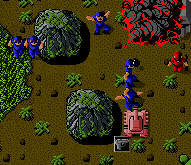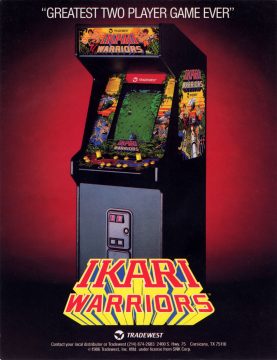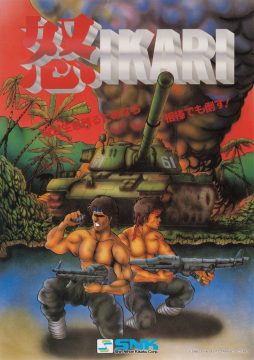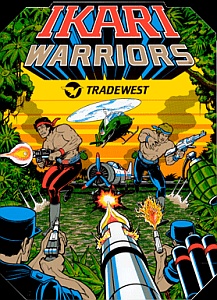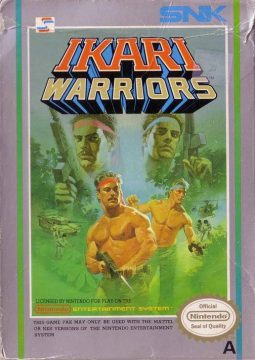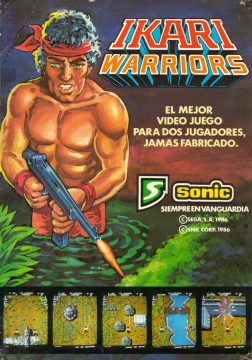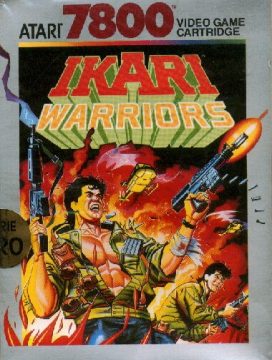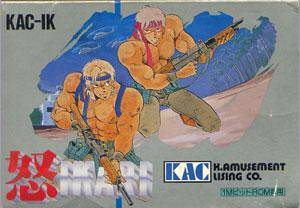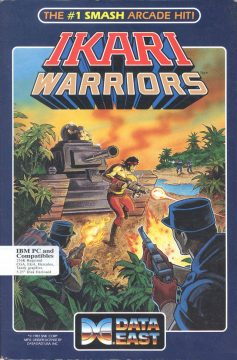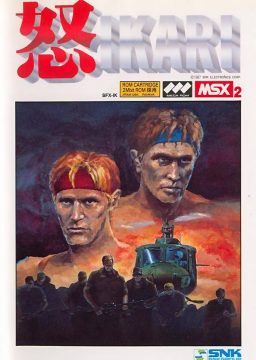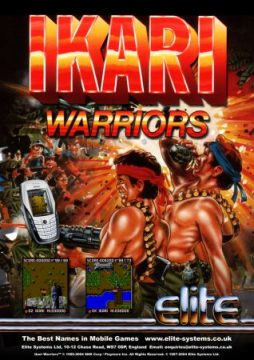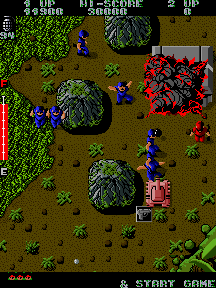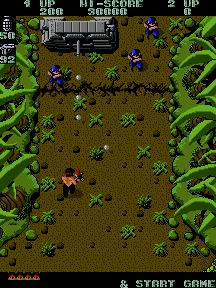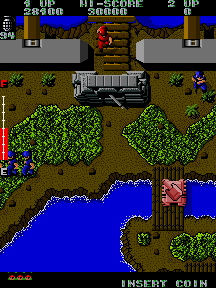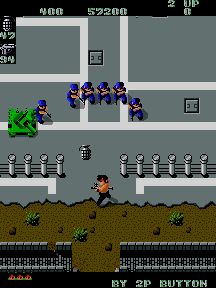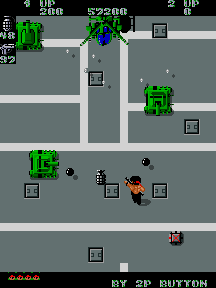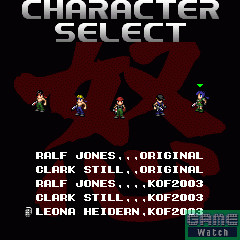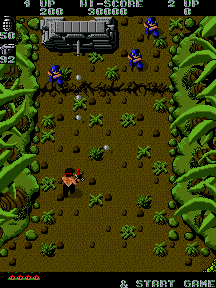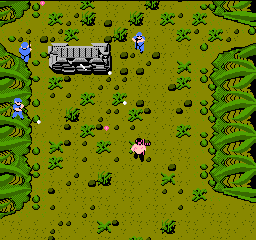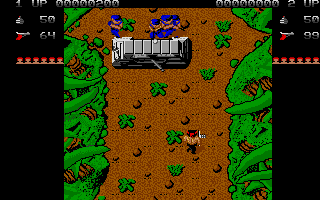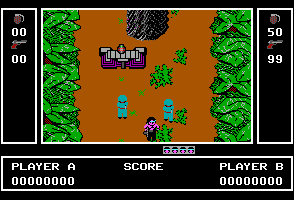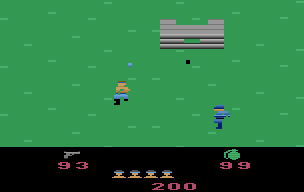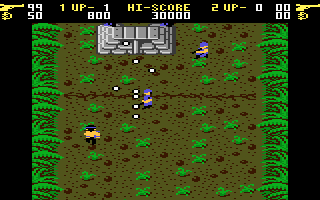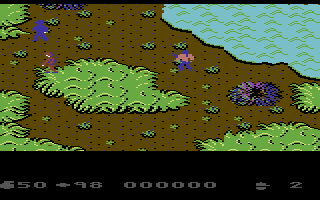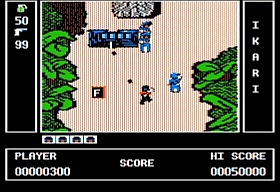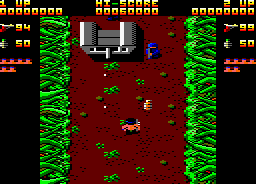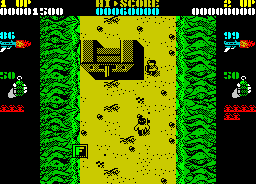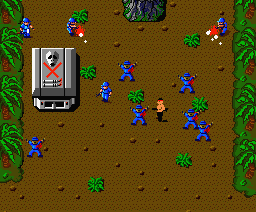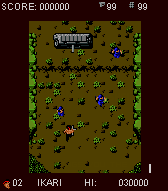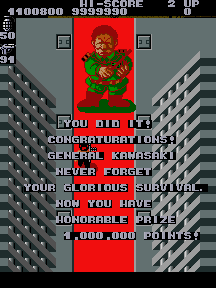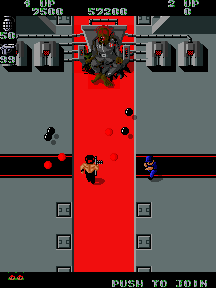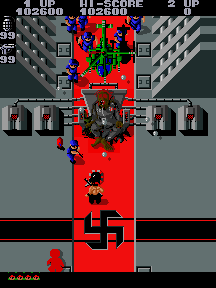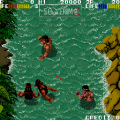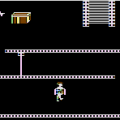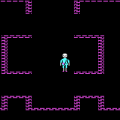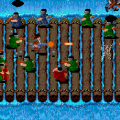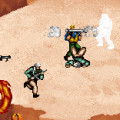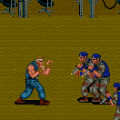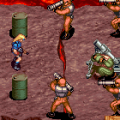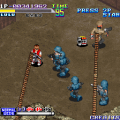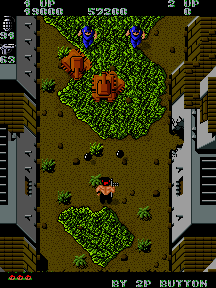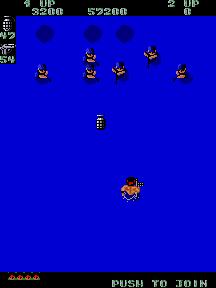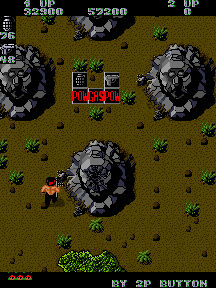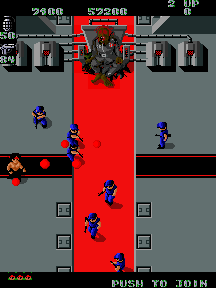SNK and Capcom have engaged in one of the most amusing company rivalries in all of video game history. As the two titans of the 2D fighting game genre, their fighters are often compared alongside each other: SNK arguably ripped off the design of Street Fighter protagonists Ryu and Ken with Ryo Sakazaki in Art of Fighting, and Capcom pinched back with Dan Hibiki in Street Fighter Alpha, making a mockery of Ryo and his pal, Robert Garcia. They’ve been jabbing at each other ever since, even taking the fight to several crossover games. However, it can be said that SNK attempted to one-up Capcom even before fighting games were popular. When another genre – namely, the shoot-em-up – was at the height of its popularity, just about every big name company took its crack at the formula. In 1985, Capcom made Commando, notable for being one of the few shooting games of the time not taking place in space, but instead in a militant war zone on foot. It allowed players to go at their own pace, to fire in multiple directions instead of only ahead, and it was just a damn fun game all around.
One year later, SNK decided that they wouldn’t let Capcom have the monopoly on the overhead run-n-gun style of shoot-em-ups. In 1986, Ikari Warriors took guerrilla carnage to a new echelon of lunacy. It featured two musclebound chaps with bandannas and big guns gallivanting about in a jungle, blasting their way through enemy forces of ambiguous ethnicity in order to save their commanding officer. The game derived heavy influence from the smash ’80s action flick Rambo: First Blood Part II; its setting and style mimic the scenic places through which the PO’ed veteran kicked ass, and the titular warriors look pretty much like Rambo himself in pixel form. The name is taken from the Japanese title of the movie, Rambo: Ikari no Dasshutsu or “Rambo: The Furious Escape”. The Ikari Warriors themselves are Ralf Jones and Clark Steel, who are best known nowadays for their presence in the King of Fighters series, and more recently, the Metal Slug games. For some bizarre reason, they were renamed to Paul and Vince in America.
It should be established right away that the Ikari games are not necessarily great by any means. Still, more light should be shed on them for the sake of history. Ikari Warriors was actually one of SNK’s hottest properties in the mid and late ’80s, and while they were good games for their time, they have aged like a lump of rotten whale meat underneath the twin suns of a foreign planet. The Ikari games may not seem to be all that much nowadays, but they were one of SNK’s big draws back in their early career.
The original trilogy was released in the arcades back when arcades were actual game rooms; dimly lit, seedy, and lined to the corners with cabinets. The first game came to a lot of consoles and home computers, while the second was released to a lesser amount of platforms. The third game appears to be the most obscure in the series and was only ported to the NES, IBM PC and Commodore 64, probably because the Rambo craze had mostly died down by the time these conversions would appear. The passing of the ’80s also seemed to be around the time when brainless-yet-awesome action films were dwindling in popularity at the silver screens in general. With that said, it’s time to bulk up, rip off your shirt, get oiled up, take up a machine gun and some grenades, and blast through a lot of crap as we take a look at the arcade versions and their respective ports.
The first game in the series is the most widely recognized, and with few other games like it at the time (aside from the aforementioned Commando and the auto-scrolling Western shooter Gun.Smoke), Ikari Warriors quickly gained notoriety for several reasons. The premise is simple: Ralf and Clark fly into South America to rescue their commanding officer, who is in enemy custody. Naturally, their plane gets shot down and they have to travel the rest of the distance armed only with their machine guns and grenades. To rescue their superior, they will have to tear through the forces of the unnamed enemy army; two men against a full force of soldiers, armed with just their strength, weapons, skill, and a ton of quarters… erm, pure courage!
The graphics are nothing to write home about, but they did the job for the time. As with many of SNK’s early titles, the colors are generally drab and submissive. As the game takes place predominantly in the jungle, you’re going to be seeing a lot of green and brown in the landscape, broken by the occasional blue of a water body or the cold industrial gray of the area near the end of the game. The animation is okay, though it’s a bit odd to see the heroes swivel their upper bodies around independently due to the manual rotation. There’s not too much to say about the sound. The effects for the bullets and explosions aren’t really all that convincing, but it’s not expected to be high-tech around this time without any realistic sound samples. The music mostly comprises of one major tune that plays all throughout, which can get tiring, but it’s a neat piece of music nonetheless. It is broken up for the moments in the game where you come across an enemy blockade (considered to be something akin to a boss fight), where the music morphs into a tense piece that also sounds decent. Overall, it’s what one would expect from a mid-’80s arcade game.
The gameplay is straightforward, aside from a peculiar rotating joystick mechanic. From a top-down view, you trudge through the jungle in a forward direction (which is straight upward from the bird’s eye view). Moving the joystick itself moves the warrior; swiveling the stick (or using whatever two keys or trackball rotation is assigned to on emulation) turns the guy in eight directions. So you can have him face the direction you want while moving in a different direction to dodge enemy fire. You use bullets for the soldier mooks and grenades for the larger machines. Both bullets and grenades are limited, but running out of ammunition somehow doesn’t seem to be a problem on this game due to A: Bullet and grenade refills being plentiful and B: The ammunition restores when you die. It is possible to enter unoccupied tanks and mow down regular enemies directly, shooting shells that move as fast as bullets and have the power of grenades; incidentally, tank shells take the same ammunition as grenades. Normal bullets only wear down the tank slightly, but a single hit from an explosive causes it to break, leaving only a few seconds to bail out before it explodes. It’s usually impossible to get out in time and run far away enough, so expect to lose a life when it’s on the verge.
The standard enemies are blue soldiers, but there are also red ones will drop power-ups that give you more ammunition, increase the power of bullets and grenades, and even kill all enemies on the screen. Soldiers will shoot at you, rush you directly, toss grenades, stalk you in the water, blast at you with flamethrowers, and apply various other antagonistic methods. Tanks move back and forth and blast you with fast-rolling missiles. Giant rock faces spit arrows out at you. Helicopters fly from above and gun you down mercilessly, and the game lets you think you can commandeer an unpiloted one when it just explodes right as you approach it. Freaking sensors pop up and summon impossible-to-avoid homing missiles when you step on them. It’s a good variety of enemies overall, but it turns out to be more than just a little overwhelming. To be frank, Ralf and Clark are not one-man armies against this actual army, and they will die. A lot. Seriously. Death occurs very frequently, as stray bullets, arcing explosives, stupid enemy mines that come out of nowhere, and a whole lot of other crap is out to kill you. Like most games of this time, the heroes die in a single hit. Lots of projectiles and hazards fly about, and the guys simply aren’t fast enough to avoid most of them.
Ikari Warriors is an arcade-designed game through and through, with its apparent aim to royally suck the quarters right out of hopelessly determined gamers. As with many arcade titles of the time, the difficulty is meant to be unfair so that players won’t be able to rip off the arcade owners by slicing through the game in one quarter. Only the best of the best can get through it without even spending five credits, perhaps ten. Also, you can only continue if you hold the fire button and press the start button while doing so; simply pressing the start button to continue boots the game from the beginning, which doesn’t make much sense.
There is indeed a definite end to the seemingly interminable landscape, but what lies at the end of the game is a gateway leading to the Twilight Zone: You make it into the enemy base, fighting off the last bastion of soldiers that rush at you in every which way. You want to kick the enemy leader’s ass, but you bet it’s going to be a hard fight. Well, when you get there, you see that the leader can’t be bothered to put up much of a battle. No, he’s not just sitting still because he’s old and decrepit. He’s worse than that: he’s dead. The final boss is a rotting corpse, sitting upright in its dictator’s chair, and somehow, this disgusting ex-human is far larger in size than Ralf, Clark, or any of the enemy soldiers. The presence of this thing is one of the many great mysteries in the epochs of gaming. Seriously, why the hell is it there?! Maybe he’s some sort of alien skeleton that died in a ship crash, but the enemy soldiers decided to worship as some sort of god? Perhaps he was born massive and died of complications brought about by gigantism, but his loyal subjects couldn’t heft his corpse off of the chair? Or maybe the developers just wanted to laugh at the ridiculous theories we devise for its presence?! Whatever the case, his chair is at least linked to four fast-firing cannons, so the fight isn’t a total walkover. Destroying the corpse leaves a rather disturbing pile of bones on the ground, but the cannons and other enemies stop as soon as you’ve re-killed their dead figurehead.
And it gets even stranger. After trouncing the inexplicably morbid quasi-boss of the game, you head on up to free your commanding officer, Colonel Cook, who is most likely named after Leland Cook, the founder of Tradewest, the company that distributed Ikari Warriors in American arcades. When you get up there, the Colonel stands stern with his baton in hand… and one look at him makes you wonder why your two puny avatars had to go through all the trouble to rescue this guy, or even how the enemies captured him in the first place. Cook (who looks like a mutant leprechaun with a sergeant hat) is the biggest freaking human in the game, even larger than the corpse, standing three times as large over everyone else. On top of this, he’s glowing red! He obviously has some sort of volatile mutant powers that he could have easily utilized to overthrow his captors and/or escape from his imprisonment. Oh, and as you could probably guess, the giant Colonel gives you a congratulatory message that barely qualifies as the game’s epilogue.
This inexplicable wackiness is worth playing through the game at least once to behold its oddity, but Ikari Warriors is overall an average game served with a side of gratuitous frustration. Still, there were not too many other games like it at the time, and it’s still a fun game to play every now and again. Any unconditional love for this game is likely the result of nostalgia combined with the great American commando craze of the ’80s. Plus, the rotating joystick is actually pretty cool, and it was one of the few games back then that allowed you to shoot in one direction while moving in another. This mechanic made it into some other SNK arcade titles besides the other Ikari games, such as Guerrilla War and SAR: Search and Rescue. Ikari Warriors was not even the first game to implement it; an overhead shooter known as TNK III, considered the forerunner to the Ikari lineage, was apparently the first game ever with a swivel joystick. The game itself also had Ralf as the pilot and pretty much played like Ikari Warriors while inside the tank.
Just to note a few minor differences in the Japanese version: The game is simply called Ikari in Japan, sans the “Warriors.” Ikari is the kanji for “anger,” which is the most appropriate emotion one can think of in regards to this game’s brutal flow of assault. The enemies are more clearly defined to be Nazis (or perhaps Neo-Nazis) with a large Swastika on the red carpet of the enemy palace. Also, Colonel Cook is called General Kawasaki (most likely named after Eikichi Kawasaki, one of the founders of SNK) and while his body is the same (gigantism and healthy crimson glow included), his head looks more like a Japanese man instead of the pseudo-leprechaun of the American version. Still makes no damn sense any way you view it.
Ikari Warriors had almost as many console and computer ports as there are bullets in an M4 clip. Naturally, none of them were up to the level of the original due to inadequate technology; i.e., none of them had a rotating joystick, so you could only shoot and fire in the same direction. Arguably the most (in)famous version was the NES home release, ported by Micronics, which takes a lot of creative liberties from the arcade game to give it a lot of new content and gameplay revisions. However, there are several instances in which less is more. This should have been one of those cases. Instead of the game being structured as one lengthy non-stop level, there are now four separate stages in the game, each individual one being almost as long as the arcade map. There are some new enemies, such as large and fast warriors that attack with clubs, elite soldiers clad in black and red, and robots, believe it or not. The rotting corpse appears at the end of stage 3 while the final boss at the end of stage 4 is a large robotic face. Once again, I am not making this up.
The heroes move slower than in the arcade game, the framerate is just abominable, and you have to input a code to continue… and even then, continues are limited. It’s even possible to get stuck and make the game unwinnable if you take the wrong path in the third stage, which is just bullshit. It does at least allow you to look in one direction while moving the other with the tank, accomplished by holding the A button and using the d-pad to aim, and you pretty much have to stay in the tank to stand a decent chance of surviving. The mandatory sea parts where you can’t drive the tank through the water and are forced to eject from them are, needless to say, unfortunate. At least you can actually enter helicopters in this game, and it’s pretty cool to mow down soldiers with a massive hail of bullets, but gas in the flying machine runs out quickly and you can’t escape, meaning that you eventually will lose a life if you enter. A myriad of factors make this troublesome translation more frustrating than fun.
The rest of the versions are closer to the home arcade game, at least in how they’re structured. The Atari 2600 version – released ridiculously late, in 1990 – is outright horrible, as were most (but not all) arcade translations of the system. This one is a possible contender for the worst of the worst due to a myriad of obfuscating factors: The “action” moves at a fat snail’s pace, it’s naturally awkward to hit most enemies, the graphics are a mess, the game actually has an ear-raping rendition of the main theme playing all throughout. explosions are completely absent and gigantic machines unceremoniously vanish when hit by a grenade, there are no power-up icons whatsoever, you can’t move diagonally while in a tank, and your tank just disappears when hit, not even giving you a chance to escape. The Atari 7800 version is miles better in comparison.
The Atari ST and Amiga versions are actually some of the better ports, though still decidedly inferior due to awkward controls and some questionable hit detection. They actually run faster than the arcade game at first, but this is before the screen becomes flooded with enemy sprites and the action slows down to a more “recognizable” pace. Still, the graphics are well done, and the sound, while somewhat muted, is not too shabby.
There are actually two Commodore 64 ports. The European one, done by Elite, has decent graphics and good sound, though relatively average music compared to the awesome potential of the SID chip. The game actually plays fast here; perhaps a bit too fast, as it is still damn near impossible to get by due to hordes of troops rushing at you from off the screen. Not too shabby a port, even if it doesn’t fix the problems of the original. In a rather cool touch, the heroes disintegrate into flesh chunks whenever they die. The USA version, done by Quicksilver Software, is substantially worse, and has completely different stages. There was also a version for the low-end model C16, which suffers from incredibly choppy scrolling. You also can only fire upwards in this version, making for a much more stiff and simple game. Like many of 8-bit computer version, it lacks music, but compared to the aural pain of the 2600’s sad attempt at music, this doesn’t seem like such a bad thing, anymore.
The Amstrad version is similar to Elite’s C64 port. The ZX Spectrum port isn’t bad per se, but it’s not all that great either. Again there’s an absence of music. The IBM PC version, also ported by Quicksilver, is actually quite a bit better. The coloring is off, seeing as how the characters are purple, but the control isn’t bad and the action is fast, depending on your CPU speed (or cycles in DOSBox). Once again no music, though.
The mobile phone version looks okay, given that it uses scaled down graphics from the arcade game, but plays terribly because, well, it’s a mobile game. These versions do let you play as the King of Fighters renditions of the characters, as well as Leona Heidern. SNK has never been that big at making their pre-Neo Geo library available to new audiences, but finally started to release the SNK Arcade Classics 0 for PSP in 2011. This contains all three Ikari Warriors games, which are also available individually via PSN as part of the PSP Minis line. They are straight emulations of the arcade originals, with huge borders on the sides due to their vertical orientation. The rotation is done with the shoulder buttons.
Screenshot Comparisons
Regional Comparisons
